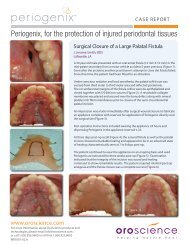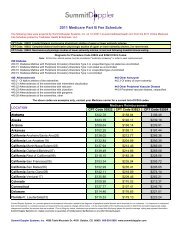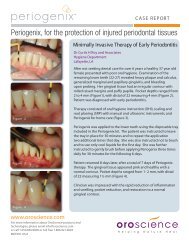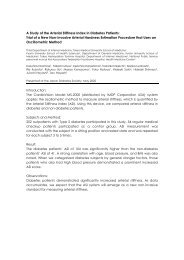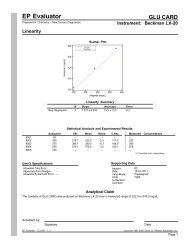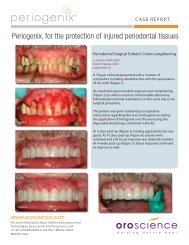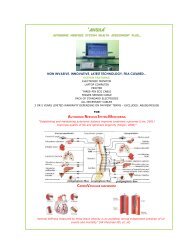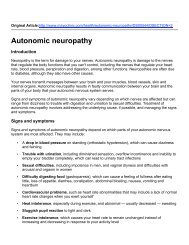White TSH - New Line Medical
White TSH - New Line Medical
White TSH - New Line Medical
Create successful ePaper yourself
Turn your PDF publications into a flip-book with our unique Google optimized e-Paper software.
EP Evaluator<br />
<strong>New</strong> Century Diagnostics, Inc.<br />
Simple Precision<br />
Report Interpretation Guide<br />
lab to control accuracy and precision separately, with<br />
reasonable confidence that Total Error will also remain in<br />
control. Recommended ranges of values are 25-50% for the<br />
Systematic Error Budget and 16-25% for the Random Error<br />
Budget.<br />
Pass or Fail?<br />
The objective is to determine whether precision is<br />
acceptable, so the standard of comparison is Allowable<br />
Random Error. The test passes if the computed SD does not<br />
exceed Allowable Random Error.<br />
Example: Suppose Allowable Total Error for Sodium is 4<br />
mmol/L, with a Random Error Budget of 25%. Allowable<br />
Random Error is 25% x 4 or 1 mmol/L. The precision test<br />
passes when the computed SD is at or below 1 mmol/L.<br />
Preliminary Report<br />
The word PRELIMINARY printed diagonally across the<br />
report indicates that the data is incomplete, and the report is<br />
not acceptable as a final report. Some or all of the statistics<br />
may be missing. Causes:<br />
• Less than 3 unexcluded results.<br />
• More than 5% of the results are outliers.<br />
Chart Interpretation<br />
Levey-Jennings Chart: A scatter plot of Standard Deviation<br />
Index (SDI) on the Y-axis vs. specimen index on the X-axis.<br />
Specimen index reflects the order in which the results were<br />
typed into the program. SDI = (Result - mean) / SD.<br />
Precision Goal: This chart appears only when Allowable<br />
Random Error is provided. It diagrams the SD and its 95%<br />
confidence interval in relation to allowable random error (the<br />
goal). The wide bar represents the SD. The fence marks<br />
above and below the SD bar show the 95% confidence<br />
limits.<br />
• The report calls the test a "pass" if the SD (top of the<br />
wide bar) does not exceed the goal. The bar is green if<br />
the test passes, or red if it fails.<br />
• If you consider all points within the 95% confidence<br />
interval to be statistically identical, you might consider<br />
the test at least marginally acceptable if the lower<br />
confidence limit does not exceed the goal.<br />
• The ideal situation is when the upper 95% confidence<br />
limit does not exceed the goal.<br />
Printed: 19 Dec 2008 22:45:11<br />
Page 3



